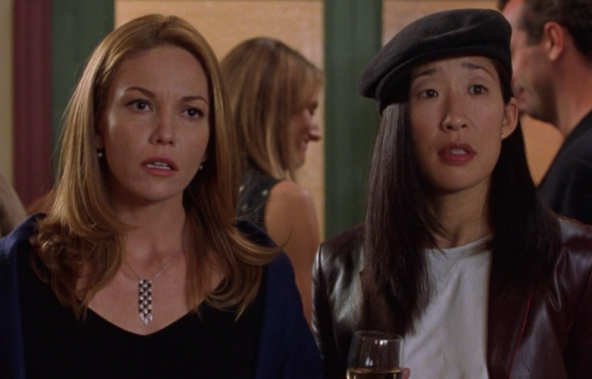
Under the Tuscan Sun has/is currently getting me through COVID. Any day I feel crushed by the looming threat of the virus, I make like Diane Lane and escape to Tuscany to worry about plumbing and wall sconces. Yes, Under the Tuscan Sun is peak “white Mom movie,” but it’s also perfect comfort food. Most of this could be laid at the feet of Diane Lane, who was going through a mid-career renaissance in 2003, fresh off her Oscar nomination for Unfaithful. She makes Frances’ quest for reinvention liberating, warm and even a bit silly. Who doesn’t need a bit of silliness in their lives?
Still, Frances would’ve never ended up in Tuscany without the help of her gay best friend, Patti (Sandra Oh)...
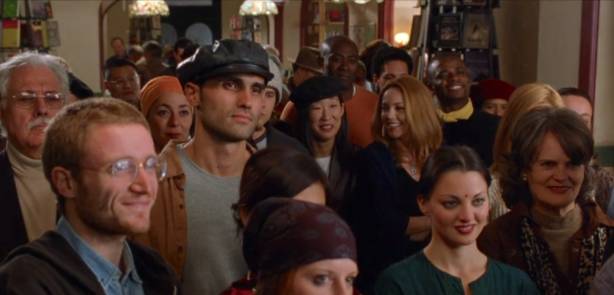 Frances and Patti are introduced together, 47 seconds into the film. Even in a crowd, they're in their own friendship bubble
Frances and Patti are introduced together, 47 seconds into the film. Even in a crowd, they're in their own friendship bubble
Let’s back up for a second and address why Under the Tuscan Sun is so utterly fabulous. It’s always seen as a beautiful adult fantasy about jettisoning one’s hum-drum life and refurbishing up an Italian villa. Yes, it is that, but it’s so much more. The film is more specifically about cutting out the toxic chunks of one’s life and rebuilding a new, more nurturing community. Not every friend makes the cut when someone goes through a major life change. However, Frances (Lane) and Patti are a friendship love that will never die. The gay best friend in rom-com is either solely a confidant or plot device. Yes, Oh’s Patti initially exists to kick start the plot. Yet, in the movie’s back half, Patti becomes a full fledged character with her own parallel journey of self-actualization and transition.
Frances and Patti are introduced as an inseparable pair at a reading of one of Frances’ students. It is here that we are dealt our inciting incident. A bitter writer takes great delight in revealing to Frances that her husband (who we never meet) has been cheating on her. The bad news keeps coming for Frances. He wants her house as well. With a fair bit of money after selling her half of the house to him, Frances is in uncharted territory.
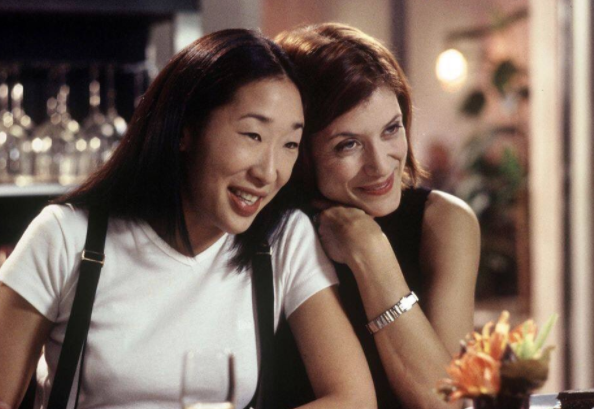 We love a Grey's Anatomy couple
We love a Grey's Anatomy couple
This is where Patti steps up with a bottle of champagne to celebrate the ending of the bad marriage. Her wife, Grace (Kate Walsh, pre-Grey’s Anatomy), arrives and they share their own great news. Patti is finally pregnant on her fifth try with a donor! While exciting news for Patti and Grace, this means they can’t go on their gay tour of Italy. Luckily, Patti knows Frances needs a break and she knows Frances won’t ask for it. She slides a first class ticket to Italy across the table. Frances is off to Italy!
This set-up plays into the “fairy Godmother” gay, where seemingly Patti only exists to get our lead to Italy for adventures. Still, it’s novel to see a happy, successful gay couple embarking on their new journey of motherhood. In 2020 standards, this looks a lot like respectability politics in play. Of course we only get a gay character if they are in a committed relationship and ready to become a traditional mother. Yet, Under the Tuscan Sun was released in a pre-Prop 8 time and there weren’t a lot of depictions of stable queer couples, much less interracial ones. Patti and Grace also exist in a romantic comedy that is otherwise specifically catered to suburban white women. The gay best friend stereotype is now seen as lazy and overused. However, in the 90s and early 00s, this characterization was a major way that rural and suburban audiences learned to accept and love queer people.
Gay people are Frances’ stewards to Italy. On the “Gay and Away” bus, Frances is whisked to a world far away from her divorce travels. She makes niceties with Dan Bucatinsky. Everyone eats great food, drinks good wine and takes lots of photos. However, Frances stumbles across a dilapidated villa in Tuscany that calls her name. Faster than you can say “bye gays,” Frances buys the house, ditches the tour and begins renovations. What follows is a delightful hour of home renovation mishaps, colorful townies and whirlwind romances.
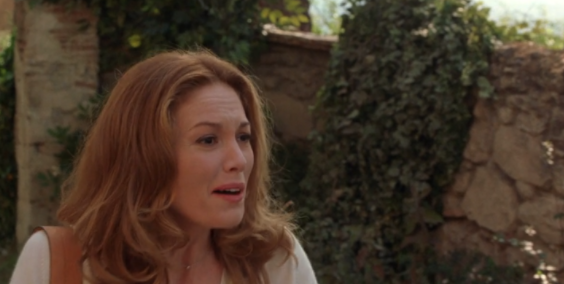
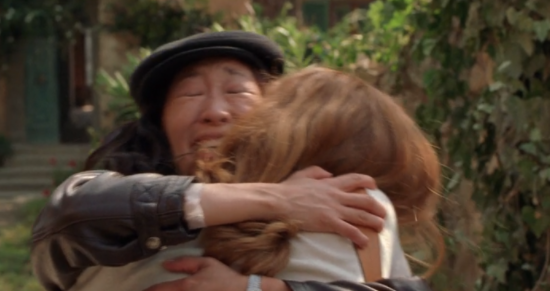
Then an old friend returns...
It’s Patti! Patti is in Tuscany! You can see all the emotions flash over Diane Lane’s face.
-
OMG, is that who I think it is?
-
Wait, how can Patti be here if she’s pregnant?
-
OMG, what’s happened?
-
Why is Grace not there?
-
OMG
-
OMG Patti’s here!
-
Patti!
I cry every single time. Like big blubbering tears. Nothing in the narrative suggests they were going to bring Patti back. Yet, writer/director Audrey Wells understands that there was a part of Frances’ life in San Francisco that was good and healthy. Having Patti in Tuscany is that touch of home she so desperately missed.
Patti: I would’ve told you I was coming, but you would’ve talked me out of flying
Frances: (crying) Look at you!
Patti: (holding back tears) You did it, Frances.
(deep breath)
Frances: What?
Patti: I gotta go pee!
It’s a perfect depiction of female friendship. I wouldn’t change it for the world.
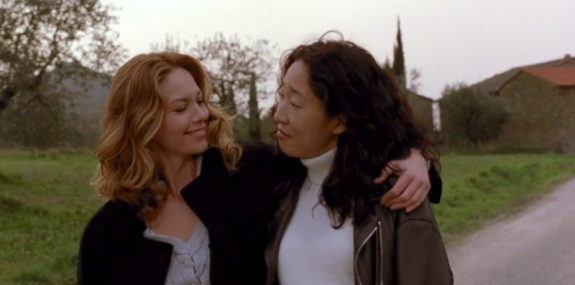
We soon learn that Grace ran out on Patti while she was in her third trimester. Apparently, Grace realized she didn’t want to be a mother. There’s a beautiful scene where Patti expresses how lost and alone she feels while Frances makes up her room. If there’s anyone who knows a thing or two about reinvention, it’s Frances. Patti is going to have her “creepy Italian baby” and Frances will be by her side.
Patti: I refuse to screw up your love life.
Frances: Don't be ridiculous, Patti. You are my love life.
This is an essential tenet to what makes Patti such a breath of fresh air. She’s Frances’ great love, and vice versa. The already delightful Architectural Digest film picks up in its second half as Frances now has a partner in crime. With Oh and Lane’s performance, you sense the both of them have a friendship where they can communicate solely with looks. There’s an unspoken bond that transcends distance. They knew they needed each other.
Lesbians aren’t often used in the “gay best friend” trope, which we established is usually reserved for cis white gay men. When we do see lesbians in these roles, it’s not often in romantic comedies. We’re more likely to see lesbian supporting characters as lovelorn friends, wishing for a world where they could run off with the lead character (see Cher in Silkwood). With Patti, Oh and Lane explore a rich and lasting friendship between friends, one of whom happens to be gay. Patti’s gayness could be explored more, sure. It’s a 2003 romantic comedy after all. Yet, her queerness is more than just a character detail. It’s an essential component to the character. We’re embroidered in her relationship and divorce.
Unfortunately, we never get to see Patti find a second love in Tuscany or have a torrid Italian romance. Granted, she’s more concerned with giving birth to her baby and nursing the wounds of her broken relationship. Still, had the movie started with both women’s lives imploding at the same time, it would’ve been great to have a more expansive, years long look at these two friends reinventing their lives in Italy. As with many of the movies we will look at in the series, there are many ways to reimagine the films around the queer characters we’re examining. However, we’re only able to do that because Patti is such a refreshing force of good in the film. Sandra Oh has also proven herself nearly two decades later to be a leading lady star.
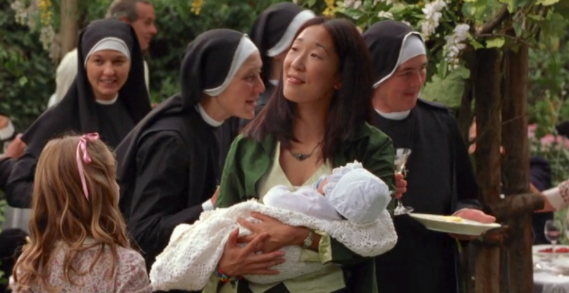 Watch out for the champagne drinking nuns, Patti!
Watch out for the champagne drinking nuns, Patti!
Martini: I think you got your wish.
Frances: My wish?
Martini: On that day we looked for your snake, you said to me that you wanted there to be a wedding here. And then you said you wanted there to be a family here.
Frances: You're right... I got my wish. I got everything I asked for.
We end at a wedding on Frances’ property between a young Polish handyman and a local girl from the town.This realization, brought on by one of Frances’ suitors, Martini (Vincent Riotta), provides a perfect cap to this feel good film. Frances’ next chapter in life was to be a force of good in the lives of the people around her. She gets to be cool Aunt Frances to Patti’s child and a confidant to her best friend. In throwing the wedding, she brings together young love that was threatened to be torn apart by tradition. Even though she’s the leading lady of the movie, Frances gets to rejoice in being a supporting character in Patti’s life as a mother. That’s the most important role of them all.
Previously in Gay Best Friend
Who is your favorite (or least favorite) example of a “gay best friend” in movies? Let us know in the comments below.